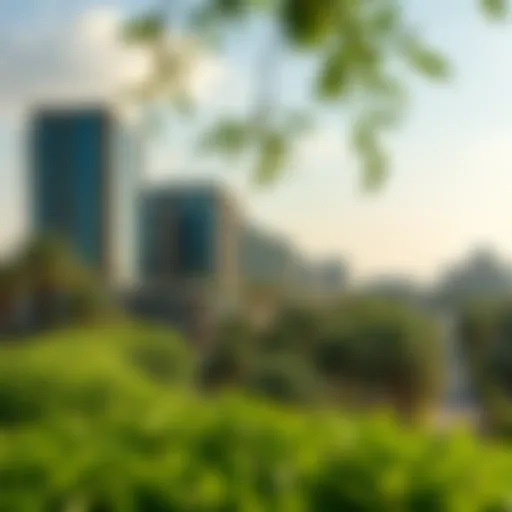Transforming the UAE Skyline: Architectural Innovations
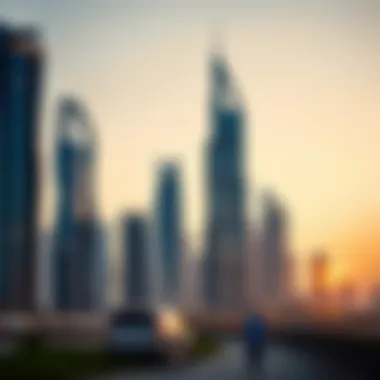

Market Trends and Analysis
The architectural landscape of the UAE is not only changing; it's evolving at a breakneck speed, characterized by unique designs, sustainable methods, and a robust market response. Investors, residents, and urban planners are keenly watching this evolution, as it holds significant implications for the real estate landscape.
Current Market Overview
Currently, the UAE's construction sector is estimated to be worth a staggering AED 160 billion. Notably, Dubai and Abu Dhabi are at the forefront, with projects that blend traditional aesthetics with futuristic designs. The Burj Khalifa remains iconic, but newer projects like the Dubai Creek Tower, which aims to surpass Khalifa's height, show how ambition fuels progress.
On a broader scale, trends are pivoting towards mixed-use developments. Residents are increasingly drawn to properties that integrate both commercial and residential spaces, allowing for a lifestyle where work and leisure exist side by side. Additionally, concepts that prioritize sustainability are gaining momentum. Architects and developers are increasingly implementing green building standards, focusing on energy efficiency and minimizing environmental impact.
Future Market Predictions
Looking ahead, projections suggest that the UAE's market will continue to flourish, with a growth rate of 7% per year until at least 2025. Factors contributing to this optimistic outlook include the nation's ongoing commitment to diversifying its economy beyond oil revenue, as highlighted by the UAE Vision 2021 strategy.
Emerging neighborhoods such as Dubai Hills and Yas Island reflect this vision, embodying modern lifestyle needs. With urbanization on the rise, we can expect to see a growing demand for rentals, especially among expatriates who prefer temporary living solutions aligned with their career paths.
"Sustainable development stands as the cornerstone of the UAE's future urban strategy, aiming to harmonize growth with environmental responsibility."
As we delve deeper into specific investment opportunities and property types, it becomes evident that the future of urban living in the UAE is poised for exciting prospects.
Investment Opportunities
As the market continues to grow, discerning investors must identify regions and property types that promise not only immediate returns but long-term viability as well.
Emerging Neighborhoods
In recent years, neighborhoods such as Dubai Marina, Jumeirah Lake Towers, and the newly developed Dubai South are becoming hotspots for both residential and commercial investments. New entries like the Mohammed Bin Rashid City are also gaining traction, catering to those who seek luxury and leisure, integrating parks, retail, and cultural hubs.
The emphasis on community living is driving demand in areas like Abu Dhabi’s Saadiyat Island, known for its art and cultural institutions. Investors flock to these regions not just for potential high returns but also for the quality of life they promise.
Types of Properties for Investment
Investors in the UAE can find a variety of property types to suit their needs:
- Luxury Apartments: With breathtaking views and ample amenities, these become highly sought after amongst wealthy expatriates.
- Townhouses and Villas: For those seeking more private living spaces, these options cater to families.
- Commercial Spaces: With the rise of mixed-use developments, investing in commercial properties aligns well with the growing trend of work-play environments.
To summarize, the architectural evolution in the UAE is more than just aesthetic changes; it's a fundamental shift in how people live and work. Keeping a finger on the pulse of emerging market trends and investment opportunities is crucial for anyone looking to navigate this exciting landscape effectively.
For more on sustainable architecture and urban planning initiatives, visit Sustainable Cities.
Organizations like Architectural Digest and The National provide insightful articles on local development.
Overview of New Developments
The rapidly changing skyline of the UAE reflects not just growth, but also a fundamental shift in architectural philosophies. This segment delves deep into the significance of these new developments. Understanding them is crucial for investors, homeowners, and urban developers alike. The structural upheaval seen in major cities around the UAE—from Dubai's iconic towers to Abu Dhabi's cultural hubs—presents a landscape ripe with opportunity and innovation.
The traditional notions of space and utility are evolving, driven by a need for modernity and sustainability in an urban environment that is more than just concrete and steel. Coupled with strategic economic initiatives, emerging architectural trends represent a confluence of art, technology, and sustainable practices. The benefits are manifold:
- Economic Growth: New buildings stimulate job creation, attracting both local and foreign investments.
- Enhanced Livability: Cutting-edge architecture often comes paired with improved amenities and services, enriching the urban environment for residents.
- Technological Integration: As modern buildings are developed, they increasingly feature innovative technologies such as smart building systems and energy-efficient designs.
With these considerations in mind, let's break down the elements defining modern architecture in the UAE.
Defining Modern Architecture
Modern architecture moves beyond traditional aesthetics, focusing heavily on functionality fused with innovation. In the UAE, modern architecture incorporates expansive use of space and light, creating not just structures, but experiences.
Key characteristics often include:
- Simplicity: Clean lines and open spaces characterize many of today's designs.
- Sustainability: An increasing commitment to sustainability results in energy-efficient builds that have minimal environmental footprints.
- Cultural Resonance: Designs now often integrate elements of local heritage, reflecting the rich history and culture of the UAE while pushing the envelope in contemporary style.
The Role of Technology in Construction
Technology is quite literally reshaping the buildings rising in the UAE. The integration of Cutting-Edge technologies simplifies processes while enhancing safety and efficiency. Building Information Modeling (BIM), for instance, has revolutionized planning, allowing for precise visualization of projects before ground is broken.
Other critical advancements include:
- 3D Printing: Increasingly employed for components and even entire structures, significantly reducing time and costs.
- Drones: Utilized for site surveys and monitoring, providing real-time data to architects and builders.
- Smart Technologies: Buildings now often feature integrated systems for energy management, security, and environmental control, creating smarter, safer, and more efficient living spaces.
Key Players in the UAE's Real Estate Market
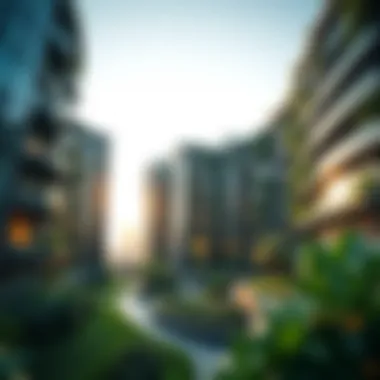

The construction and architectural landscape in the UAE is marked by several influential players shaping its future. Among them are prominent developers like Emaar Properties, Aldar Properties, and DAMAC Properties. These companies lead the charge in innovation and sustainability, driving forward contemporary building trends.
"Investors are keeping a keen eye on these developers, who not only bring significant financial leverage but also set standards for quality and sustainability."
Additionally, collaboration with international architectural firms ensures that the projects meet global standards while incorporating local insights. This multifaceted approach positions the UAE as a beacon for architectural excellence and innovation in the Gulf Region.
Notable Architectural Projects
The UAE is fast becoming a hotbed of architectural marvels, with each new building encapsulating a blend of innovation and tradition. These notable architectural projects aren’t merely constructions; they represent a strategic vision for the future of urban living in the region. Understanding these developments helps investors and homebuyers appreciate what the landscape is changing into. They signify growth in cultural identity and establish a competitive edge in the international real estate market, which in turn brings economic benefits.
Flagship Towers of Dubai
Flagship Towers in Dubai have become iconic for more than their sheer height. One particular standout is the Burj Khalifa, but it’s not just about the renowned structures. Developments like the Dubai Creek Tower, albeit still under wrapping, already hint at ambitious designs and futuristic features. Integrating advanced construction technologies, these towers symbolize both luxury living and sustainable principles in architecture. Not only do they attract tourists, but they also provide vertical living spaces for a burgeoning population.
The design aesthetics often draw from cultural motifs, combining glass facades with intricate patterns inspired by the rich history of the UAE. The skyline tells a story of continuous evolution, merging futuristic vision with rich heritage.
Dubai is known for its exuberance but these Flagship Towers also emphasize accessibility and inclusivity, transforming how both locals and visitors experience urban life. Investors are keenly interested in these developments due to their prime locations and the potential for high returns on investment, making them an attractive proposition for anyone keen on diving into the Emirati real estate market.
Residential Complexes in Abu Dhabi
Shifting attention to Abu Dhabi, the residential complexes here are becoming increasingly sophisticated yet highly livable. Developments like Al Reem Island and Saadiyat Island offer integrated spaces designed for comfort and community. These complexes are not simply about aesthetics; they are a response to the growing need for sustainable and family-oriented living.
The architectural designs often reflect the surrounding landscapes, aiming for harmony with nature while ensuring a modern living experience. Features like green spaces, parks, and pedestrian-friendly areas give residents a sense of place alongside luxury. For potential homeowners or seasoned investors, these complexes offer amenities that cater to various lifestyles, whether it's a focus on family, entertainment, or wellness.
Moreover, the demand for these residential spaces is on the rise, driven in part by expats looking for high-quality living environments. This trend underscores the importance of positioning in real estate investment strategies.
Sustainable Urban Developments
As the global narrative shifts toward sustainability, the UAE is stepping up its game with innovative urban developments that prioritize environmental consciousness. Projects like Masdar City are not just ambitious; they serve as benchmarks in green architecture worldwide. The zero-carbon city aims to redefine how urban centers can operate sustainably, incorporating renewable energy sources and minimizing waste.
Building designs in these areas are equipped with state-of-the-art energy-efficient technologies, from solar panels to smart building systems that optimize resource utilization. Sustainability is paramount, but there's also a focus on aesthetics, with designs that offer a vibrant and inviting atmosphere.
The commitment to sustainability fosters long-term economic viability, particularly among investors looking for eco-friendly opportunities. Not only do these projects attract a specific demographic but they also resonate with a global audience increasingly concerned with climate change. As urban planners, homeowners, and investors pivot towards sustainability, the landscape of the UAE continues to shift, promising a future that's both innovative and responsible.
Architectural Trends and Aesthetics
In recent years, the architectural landscape of the UAE has seen a remarkable evolution shaped by various aesthetic and cultural influences. Architectural trends and aesthetics are vitally important to this transformation because they reflect the social values, lifestyle aspirations, and functional needs of a diverse population. The way buildings are designed influences not just the skyline of cities like Dubai and Abu Dhabi, but also the daily experiences of residents and visitors alike. Aesthetic considerations improve the visual appeal of urban spaces while considering practicality and tradition.
Influence of Cultural Heritage
Cultural heritage plays a pivotal role in defining architectural aesthetics within the UAE. The infusion of local artistry and traditional motifs into new buildings establishes a narrative that pays homage to the past. For instance, the integration of wind towers—known as barjeel, traditionally used for natural ventilation—into modern structures symbolizes a bridge between history and innovation. Moreover, Islamic geometric patterns often adorn facades, windows, and interiors, providing a cohesive feel to the urban landscape.
- Local Identity: Incorporating cultural elements fosters a sense of belonging among residents.
- Touristic Appeal: Unique designs rooted in heritage attract visitors, adding economic value.
- Civic Pride: Focusing on cultural aesthetics helps promote pride in local identity, resonating strongly across generations.
As the UAE continues to grow, there is a delicate balance architects must strike between preserving cultural heritage and accommodating modern needs. This rich blend ultimately enhances the emotional resonance of buildings, which becomes evident when one strolls through historic districts juxtaposed with towering skyscrapers.
Minimalism vs. Opulence in Design
The architectural debate of minimalism versus opulence is particularly pronounced within the UAE. On one hand, minimalist designs advocate for simplicity—clean lines and functional spaces—reflecting a more practical approach that suits the fast-paced lifestyle of many expatriates and locals. This design philosophy emphasizes.
- Space Utilization: Well-thought-out layouts allowing room for adaptability.
- Clarity: Reduced clutter leads to mental ease and improves productivity.
- Sustainable Concepts: Using fewer resources in design promotes environmental sustainability.
On the other hand, the allure of opulence can still be seen throughout major developments, where lavish designs and grandiose features evoke a sense of luxury. This style—often characterized by the use of extravagant materials and eye-catching details—marries the notion of status with architectural beauty.
- Symbolism: Opulence often represents success and wealth, resonating with high-profile clientele.
- Experience: Opulent designs offer immersive experiences, often found in high-end hotels and retail spaces.
Ultimately, the street views in the UAE are a vivid testament to the coexistence of these two styles, where serene minimalist condominiums share space with opulent commercial buildings inviting admiration.
Integration of Natural Elements
As urban environments grow denser, the integration of natural elements in architectural design has gained significant traction in the UAE. Architects and developers recognize that incorporating greenery and natural materials not only enhances aesthetic appeal but also promotes residents' well-being.
- Biophilic Design: Emphasizes people's connection to nature, improving air quality and reducing stress. Integrating plants into building designs can create a refreshing sense of calm amidst the urban hustle.
- Water Features: Incorporating elements like fountains or retention ponds can help mitigate heat, bringing a cool respite in the desert climate. Plus, they provide a serene backdrop.
- Sustainable Materials: The use of local timber, stone, and other sustainable materials resonate with environmental consciousness while harking back to traditional construction methods.
This synergy between built environments and nature leads to innovative designs, transforming rooftops into gardens and facades into vertical forests. The presence of such elements is not merely for show; it aims to dissolve the hard boundaries of urban life.
The consideration of natural elements in architecture signifies a broader trend towards creating resilient, livable cities that harmonize us with our surroundings.
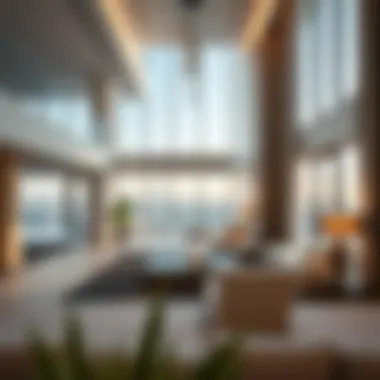

Sustainability in New Buildings
Sustainability has carved out a vital niche in the architectural landscape of the UAE. As global awareness around environmental issues continues to grow, the importance of sustainable practices in new buildings cannot be overstated. This approach not only addresses the current ecological concerns but also ensures a viable future for urban living amid rapid urbanization. By adopting sustainable practices, stakeholders can significantly enhance the quality of life for residents and contribute to economic prosperity.
Green Building Standards
Green building standards have become the backbone of sustainable development in the UAE. These standards, such as the Estidama Pearl Rating System, aim to measure the sustainability of buildings. They incorporate techniques that minimize energy use, reduce water consumption, and promote healthier living environments by utilizing non-toxic materials. Developers are increasingly recognizing that adherence to these standards not only fulfills regulatory obligations but also attracts eco-conscious buyers, thus enhancing marketability.
- Benefits include:
- Decreased energy costs due to improved efficiency.
- Enhanced indoor air quality through valid ventilation strategies.
- Promotion of a sustainable urban image, appealing to a global audience.
Energy Efficiency Initiatives
Energy efficiency initiatives represent another critical component in the effort to achieve sustainability in new buildings. The UAE has seen a bullish move towards integrating energy-efficient technologies. These measures can include solar panels, high-performance insulation, and smart systems that regulate energy use according to real-time data. This leap towards adopting modern technologies reduces reliance on non-renewable resources.
"Investing in energy-efficient building methods today directly translates into long-term savings and a smaller carbon footprint tomorrow."
- Some key initiatives in the UAE are:
- The Dubai Energy Efficiency Program, which aims to reduce power consumption by 30% by 2030.
- Abu Dhabi's target to generate 7% of its energy from renewable sources by 2020, with ongoing initiatives to surpass this goal.
Waste Reduction in Construction
Waste reduction in construction is becoming increasingly necessary as the region strives to manifest sustainable urban environments. Construction activities typically generate significant amounts of waste; however, new strategies aim to minimize this. This involves strategies such as reusing materials, recycling concrete, and employing modular construction techniques.
- The practical benefits include:
- Lower disposal costs owing to reduced waste output.
- Strategic planning, resulting in efficient use of resources throughout the construction lifecycle.
- Enhanced reputation among investors and the community for being environmentally responsible.
As the UAE continues to evolve, integrating sustainability within the fabric of new buildings is not just a tick-box exercise. It's a commitment to a more sustainable urban future and addressing global issues head-on. By exercising due diligence in sustainable practices, the UAE can be at the forefront of architectural innovation while taking care of its environment.
Economic Impact of New Developments
The significance of economic impact when talking about new developments in the UAE cannot be understated. As this region pushes boundaries with its architectural ambitions, one must consider how these advancements shape more than just the skyline; they reshape lives, influence investment landscapes and wage wars on unemployment. New architectural projects feed into an ever-growing narrative about the financial vitality and urban dynamism of the UAE, presenting not just beautified cities, but also potential avenues for profit and progress.
Investment Opportunities
With the surge in new developments, investment opportunities continue to expand in the UAE real estate sector. High-net-worth individuals, as well as institutional investors, have their eyes peeled for lucrative prospects. Take the example of the Burj Khalifa, which catalyzed a wave of developmental projects in the surrounding area; investors saw the air-dried desert morph into a flourishing urban hub.
- Diverse Portfolio Options: Whether one is looking at luxury residential spaces, commercial real estate, or mixed-use developments, there's something for everyone.
- Government Incentives: The UAE government offers various incentives, like tax-free zones, which attract foreign investment.
- Upcoming Mega Projects: Projects such as the Dubai Creek Tower are slated to become landmarks and economic hotbeds. The anticipation creates a buzz that every savvy investor wants to tap into.
As these unique projects unfold, the projected return on investment often catches the eye. Investors are not just purchasing property; they are buying into a vision of the future that brings substantial financial returns.
Job Creation in the Real Estate Sector
New construction projects in the UAE serve as a beacon for job creation. The much-talked-about projects not only draw attention but also pave the way for employment opportunities across various sectors. The construction phase alone requires thousands of hands—skilled and unskilled alike.
- Construction Jobs: Contractors need laborers, architects, engineers, and countless other specialists. A bustling job market is often a sign of economic health.
- Long-term Positions: After completion, these developments will require management, maintenance, and service personnel, ensuring stable employment.
- Training and Development: Programs aimed at workforce development are crucial. They not only enhance skills but also ensure the employment landscape evolves alongside new developments.
In times of rapid growth, as seen in the UAE, the ripple effect often extends into various industries, making job creation not just a matter of construction but a matter of overall economic stability.
Impact on Local Economies
The local economies in the UAE are experiencing significant shifts due to new developments. These structures create not just jobs but also stimulate ancillary businesses.
Challenges Facing New Construction
The architectural landscape of the UAE is in a constant state of flux, shaped not only by innovative designs but also by the real challenges that come with new construction projects. Understanding these challenges is crucial for investors and stakeholders who are keen on navigating this ever-evolving field. The stakes are high as these hurdles can influence project timelines and budgets, thus making clear the importance of recognizing and addressing them head-on.
Regulatory Hurdles
Regulatory frameworks are often labyrinthine. In the UAE, navigating the local laws and regulations can feel like trying to find your way out of a desert without a map. Each emirate possesses its own set of rules regarding land use, building codes, and zoning laws, making consistency a real headache. This can lead to a host of delays as developers must secure numerous permits and approvals.
Moreover, government agencies have been known to change regulations on a whim, which can throw a wrench into even the most well-laid plans. Projects can stall if developers are unprepared for additional requirements that arise late in the game, which not only adds to costs but can also sour investor confidence.
Competition in the Market
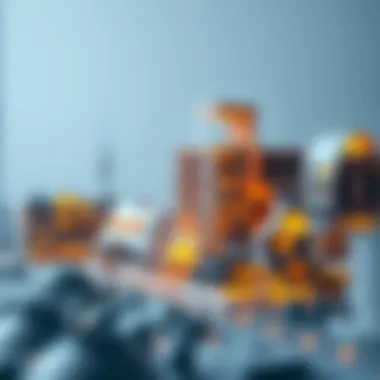

Competition is fierce, making it a double-edged sword. On one hand, it can lead to innovation and quality improvements as businesses strive to differentiate themselves. On the other, developers often find themselves in a race to finish projects quickly, sometimes at the expense of quality or sustainability.
In a crowded market, where the skyline is littered with ambitious projects, standing out becomes imperative. This is especially true for developers looking to attract foreign investors navigating the waters of the UAE real estate market. Being attuned to emerging trends, such as developments in smart building technologies, can give a competitive edge. However, if one misreads the market or miscalculates demand, it could turn into a costly blunder.
Supply Chain Disruptions
Supply chain issues have plagued the construction industry, and the UAE is certainly no exception. The pandemic has exposed vulnerabilities in the global supply chain, leading to increased costs and delays in material delivery. It can be likened to trying to build a sandcastle at low tide; just when you think you're making progress, the waves come crashing in, and you have to start over.
Material shortages, particularly for specialized building elements, are a continual concern. Developers must build in flexibility to their timelines and budgets to accommodate these unavoidable hiccups. Such disruptions not only impact project completion dates but also ripple through the local economy, affecting jobs and further investments.
"To thrive in the current climate, adaptability and foresight are not just assets but necessities for successful project execution."
In summary, while the challenges facing new construction in the UAE can often seem daunting, they also present opportunities for strategic innovation and resilience. For anyone considering involvement in this vibrant yet unpredictable market, a comprehensive understanding of these obstacles is vital.
Future of Urban Living
The future of urban living is pivotal, particularly in a region like the UAE, where skyscrapers rise alongside tradition. As the country experiences rapid growth, understanding the emerging paradigms of urban living becomes crucial for investors, homeowners, and urban planners alike. With a blend of innovative designs, technology, and sustainability considerations, the landscape of urban life is shifting towards something that meets modern demands while respecting cultural roots.
This section will delve into how emerging trends are reshaping residential and commercial spaces, emphasizing the integration of technology and architectural creativity in addressing both current and future needs.
Trends in Smart Cities
Smart cities are becoming the cornerstone of urban planning in the UAE, transforming the way residents interact with their environment. The big focus is on technology-driven solutions that not only enhance efficiency but also improve quality of life. From smart traffic management systems to energy-efficient building designs, every aspect is being enhanced by cutting-edge technology.
- Connected Infrastructure: Sensors and IoT devices allow for real-time monitoring of everything from traffic patterns to energy usage.
- Data-Driven Decision Making: Analyzing large volumes of data helps cities to optimize resource allocation.
- Community Engagement: Platforms for residents to report issues or suggest improvements create a collaborative urban environment.
The shift toward smart city frameworks isn't just about convenience—it's also about sustainability. Urban areas can reduce their environmental footprint through intelligent management of resources, taking full advantage of renewable energies and efficient waste management systems.
Resilience in Urban Planning
In the face of challenges such as climate change and rapid urbanization, resilience has become a guiding principle in UAE’s urban planning initiatives. Resilient planning entails creating environments that can withstand and adapt to various external pressures.
- Climate Adaptation: Designing buildings and infrastructure that can withstand extreme weather conditions is key. The use of sustainable materials and methods is gaining traction.
- Community Cohesion: Resilient urban areas promote social interaction and cohesion, creating spaces where communities can thrive together in the face of adversity.
- Emergency Preparedness: Smart infrastructure also includes systems that anticipate and respond to crises, ensuring the safety and wellbeing of residents.
This approach not only mitigates risks but also empowers communities, making them active participants in shaping their environments.
Evolving Lifestyle Choices
As urban living evolves, so too do the lifestyle choices of residents. The UAE's diverse populace has different needs and aspirations, driving demand for varied residential options and amenities. Today's urban population seeks environments that cater to their preferences.
- Flexible Living Spaces: The rise of co-living spaces reflects a shift towards shared living arrangements, particularly among younger professionals and expatriates. These spaces often encourage collaboration and foster a sense of community.
- Access to Amenities: People increasingly favor neighborhoods that provide easy access to recreational areas, shopping centers, and transportation links. Walkable communities are becoming more desirable.
- Health and Well-being: Incorporating parks, walking trails, and fitness facilities within urban designs shows a strong emphasis on health-conscious living.
This focus on evolving lifestyle choices signifies a shift towards more holistic approaches in residential planning, weaving wellbeing into the fabric of urban living.
In summary, the future of urban living in the UAE is marked by technological integration, resilience, and adaptability to changing lifestyle preferences. As architects and urban planners respond to these emerging trends, the potential for innovation remains vast.
Ending
In the fast-paced world of architecture in the UAE, the closing insights presented in this article highlight the dynamic shifts shaping urban landscapes. New buildings are not merely structures; they are reflections of evolving cultures, technologies, and sustainable practices. At the heart of these changes is the realization that modern architecture must embrace not only aesthetic value but also functionality and environmental consciousness.
Summary of Insights
The discussion throughout the sections pinpoints several key themes worth emphasizing:
- Innovative Designs: Architects are pushing the envelope, creating designs that blend traditional elements with modern functionality.
- Technological Integration: Advancements in construction technology are revolutionizing the speed and efficiency of building processes, while smart home features enhance the living experience for residents.
- Sustainable Practices: As the region responds to climate challenges, the integration of environmental strategies during construction is crucial. The rise of green buildings indicates a long-term commitment to sustainability.
All these elements contribute significantly to how investors, homeowners, and urban planners perceive the future of the UAE.
Implications for Future Investments
With the backdrop of these architectural advancements, investors should pay keen attention to the implications at hand. The UAE's real estate market showcases robust opportunities:
- High Demand for Dynamic Spaces: As expatriates flock to the UAE for work and leisure, the demand for versatile, appealing spaces is set to rise.
- Value in Sustainable Developments: Property investments that focus on sustainability are likely to see heightened interest from eco-conscious buyers, thus holding more value in the long run.
- Urban Resilience as a Selling Point: Developments prioritizing resilience and adaptability to climatic changes will attract informed investors who place a premium on sustainability.
These trends indicate a shift toward forward-thinking investments that align with environmental sensibilities.
Final Thoughts on UAE's Urban Landscape
As we wrap up this exploration of the UAE's architectural evolution, it becomes evident that the intersection of culture, technology, and sustainability is redefining urban life. The structures that rise along the skyline today will shape the experiences of future generations. Furthermore, engaging with these architectural trends not only provides substantial investment opportunities but also enriches the lives of those who inhabit these spaces. The UAE stands poised to lead as a beacon of innovation, illustrating how thoughtful design can contribute to a vibrant urban fabric and a sustainable future.
"The buildings we create are more than mere shelters; they are living reflections of our culture and ambitions."
This thoughtful approach to architecture will continue to pave the way for a progressive and inspiring urban landscape in the UAE.







